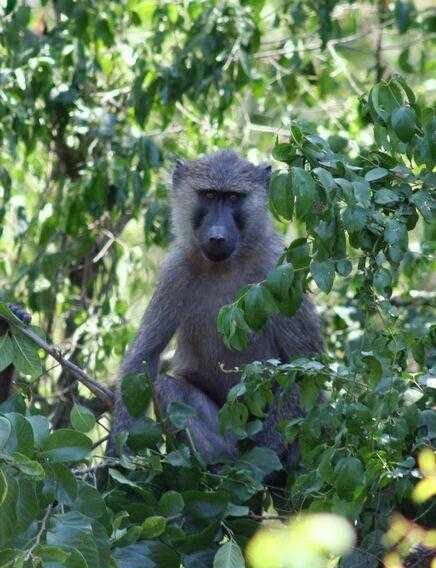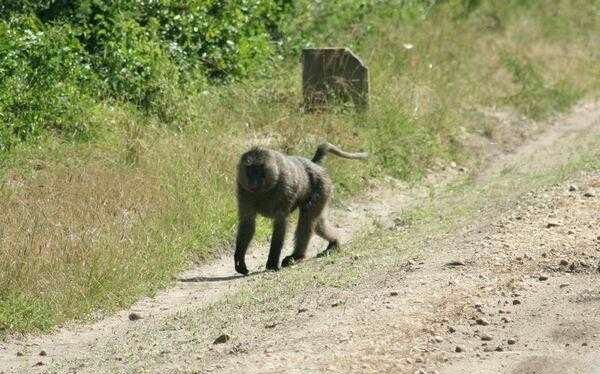Baboons scientifically named as Olive baboon, Papiocynocephalus anubis,Yellow baboon ,Papio ynocephalus cynocephalus.
How to identify a baboon.The two most common baboons occur in East Africa, the olive baboon and the yellow baboon. The larger and darkerolive baboon is found in Uganda, west and central Kenya and northern Tanzania. Smaller, more slender and lighter in colour, the yellow baboon inhabits southern and coastal Kenya and Tanzania. Both types are "dog faced," but the yellow's nose turns up more than the olive's.The only type found in Uganda is the Olive Baboon and they occur in all but the three Montane National Parks and are frequently seen on the fringes of forest reserves and even along the roadside elsewhere in the country.
Where to find baboons.Baboons are found in surprisingly varied habitats and are extremely adaptable. The major requirements for any habitat seem to be water sources and safe sleeping placesin either tall trees or on cliff faces. When water is readily available, baboons drink every day or two, but they can survive for long periods by licking the night dew from their fur.
Behavior.Baboons usually leave their sleeping places around 7 or 8 a.m. After coming down from the cliffs or trees, adults sit in small groups grooming each other while the juveniles play. They then form a cohesive unit that moves off in a column of two or three, walking until they begin feeding. Fanning out, they feed as they move along, often traveling five or six miles a day. They forage for about three hours inthe morning, rest during the heat of the day and then forage again in the afternoon before returning to their sleeping places by about 6 p.m. Before retiring, they spendmore time in mutual grooming, a key way of forming bonds among individuals as well as keeping the baboons clean and free of external parasites.
Baboons sleep, travel, feed and socialize together in groups of about 50 individuals, consisting of seven to eightmales and approximately twice as many females plus theiryoung. These family units of females, juveniles and infantsform the stable core of a troop, with a ranking system that elevates certain females as leaders. A troop's home range is well-defined but does not appear to have territorial borders. It often overlaps with the range of other baboons, but the troops seem to avoid meeting one another.When they begin to mature, males leave their natal troops and move in and out of other troops. Frequent fights breakout to determine dominance over access to females or meat. The ranking of these males constantly changes during this period.Males are accepted into new troops slowly, usually by developing "friendships" with different females around the edge of a troop. They often help to defend a female and her offspring.
What Baboons eat.
Reproduction.Just below the tail, on the rump area are horny epidermal callosities. With females in oestrus, the callosities swell upsubstantially and serve as clear signal to the males of theirbreeding condition.The dominant males herd and mate with the females in oestrus. The Alpha male does most of the mating.Young males that have no dominant ranking within the troop have no mating rights. Mature females in most cases won’t give them the opportunity to mate unless the social bond between two is very strong. This type of mating is not tolerated by the dominant males and could prove very dangerous for the young male if caught in the act.After a successful copulation from one male or a number of different males, the female then goes through a 6 month gestation period and gives birth to a single offspring. Females can give birth at any time of the year.Caring for the YoungFor the first month, an infant baboon stays in very close contact with its mother. The mother carries the infant next to her stomach as she travels, holding it with one hand. By the time the young baboon is 5 to 6 weeks old it can ride on her back, hanging on by all four limbs; in a few months it rides jockey style, sitting upright. Between 4 and 6 months the young baboon begins to spend most of its time with other juveniles.
Predators.The baboon's major predators are humans. Knowing that humans can easily kill or injure them when they are in trees, baboons usually escape through undergrowth. Males may confront other predators like leopards or cheetahs by forming a line and strutting in a threatening manner while baring their large canines and screaming. Baboons are fierce fighters, but a demonstration such as this can put the predator on the run.
Did you know? Nearly one-half the size of adult males, females lack the male's ruff (long hairs around the neck), but otherwise theyare similar in appearance.Baboons use over 30 vocalizations ranging from grunts to barks to screams. Nonvocal gestures include yawns, lip smacking and shoulder shrugging.
I guess now you have some knowledge about baboons, support and care about the wildlife. #Embrace the wildlife nature.


Hey baboon!
Hi! I am a robot. I just upvoted you! I found similar content that readers might be interested in:
https://www.youtube.com/watch?v=7FElqgxmiWE